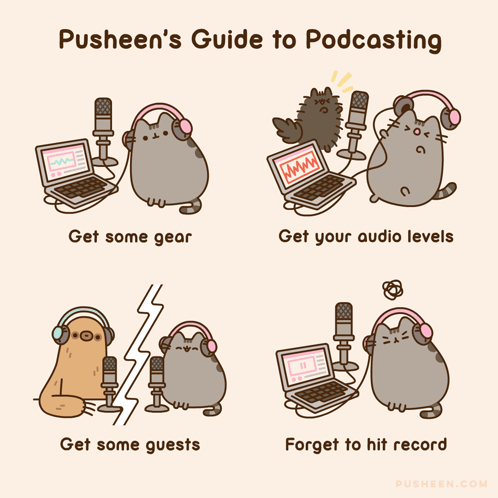Master Podcast Episode Structure and Pacing: A How-To Guide
Welcome to our guide on mastering podcast episode structure and pacing. We'll help you create engaging episodes that keep listeners coming back for more. We'll explore strategies, tips, and best practices to improve your podcast's quality and audience engagement.
Key Takeaways
- Use a short intro to deliver immediate value
- Implement the 5 SEO clips method for interview-style shows
- Measure your Time To Value (TTV)
- Maintain consistent episode length and pacing

Understanding the Basics of Podcast Episode Structure
A well-structured podcast episode is like a good story. It has a beginning, middle, and end that keeps listeners engaged throughout. Let's break down the three-act structure that works well for many podcasts:
Act 1: Setup and Hook
Start your episode with something interesting! Grab your listeners' attention right away with a fun fact, question, or teaser about what's coming. This is where you set the stage for your episode and give listeners a reason to keep listening. You could use a cool story or a thought-provoking statement related to your main topic. The goal is to make your audience curious about what's next.
The best hooks make the listener/viewer think the episode was made especially for them, and delivers it with a hook within the first 30 seconds of the episode. That's how long most Youtube viewers give an episode before deciding if they are going to click off or stick around - so make it count!
Act 2: Main Content and Challenges
This is the main part of your episode. Talk about your main topics, interview your guest, or explore the challenges related to your subject. Keep things moving by breaking this section into smaller parts or discussing different aspects of your main theme. Use transitions to guide your listeners smoothly from one point to the next. If you're interviewing someone, make sure both of you get to talk and ask follow-up questions to learn more about interesting points.
Act 3: Resolution and Call-to-Action
Wrap up your episode by summarizing key points, providing a satisfying conclusion, and giving your listeners something to do next. This could be asking them to subscribe, leave a review, or check out your website for more information. Make sure to tie back to your opening hook and answer any questions you brought up earlier in the episode.
At Podigy, we offer podcast editing services that can help you perfect this structure and create a polished final product

The 5 SEO Clips Method for Interview-Style Shows
The 5 SEO Clips Method for Interview-Style Shows
For interview-style podcasts, we recommend using the 5 SEO clips method. This approach helps you structure your interviews effectively and create content that's easy to reuse. Here's how it works:
Select 5 Broad Topics
Choose 5-10 main topics that you know your guest can talk about for 5-10 minutes each. These should be interesting subjects that your audience will find valuable. Think about what your guest knows a lot about and what your audience likes when picking these topics. This method allows for a good discussion while staying focused and covering different things.
Start Strong, End Strong
Begin with your most interesting topic to hook listeners right away. This will be what you structure the title/episode artwork/thumbnail around. Save your second-best idea for last to end on a high note. This structure makes sure you grab your audience's attention from the start and leave them with something good to remember at the end. You can arrange the middle three topics based on what makes sense or by increasing difficulty.
Manage Your Time
Try to spend 5-10 minutes on each topic. This keeps the conversation moving and prevents any single subject from taking over the episode. Use gentle transitions or brief breaks to move from one topic to the next. This pacing helps keep listeners interested and ensures a well-rounded discussion.
Using this method helps you create a well-paced interview that covers a variety of topics while keeping listeners interested. It also makes it easier to create short videos for social media later on. Each segment can be used as a standalone clip, getting the most value out of your content.

Crafting an Engaging Introduction
Crafting an Engaging Introduction
Your podcast intro is really important - it's your chance to hook listeners and set the tone for your episode. Here are some tips for creating a great intro:
Keep it Short and Sweet
Aim for an intro that's no longer than 30-60 seconds. You want to give listeners just enough information to get them excited about what's coming. A short intro respects your audience's time and quickly gets to the main part of your content. Remember, first time listeners/viewers will be clicking through to get resolution to the curiosity gap you created with your title and artwork, the quicker you can start delivering on that, the more likely they are to stick around.
Deliver Immediate Value
Start with something interesting right away. This could be a cool fact, an interesting question, or a teaser about what listeners will learn in the episode. The goal is to make them curious and give them a good reason to keep listening.
Set Clear Expectations
Let listeners know what the episode is about and why they should keep listening. This helps them decide if the content is interesting to them. Briefly outline the main points you'll cover or mention any special guests. This honesty helps build trust with your audience.
Remember, your intro sets the stage for the rest of your episode. Make it count! For more tips on making your podcast sound great, check out our guide on EQ for podcasters.

Maintaining Pace Throughout the Episode
Maintaining Pace Throughout the Episode
Keeping a good pace is key to holding your listeners' attention. Here are some strategies to help you maintain a steady rhythm:
Use Smooth Transitions
When moving between topics or segments, use clear transitions. This helps listeners follow along and understand the structure of your episode. You can use words, short music breaks, or even sound effects to signal a change in topic or mood.
Incorporate Audio Elements
Use music, sound effects, and audio transitions to break up your content and keep things interesting. Just be careful not to overdo it - these elements should make your content better, not distract from it. Thoughtfully placed audio elements can help reinforce your message and create a more immersive listening experience.
Balance Speaking Time
If you're hosting an interview, aim for a good balance between your speaking time and your guest's. Let your guest shine, but don't be afraid to guide the conversation and ask follow-up questions. A well-balanced dialogue keeps the energy high and ensures that both host and guest contribute meaningfully to the discussion.
One of the best ways to get out of the guest-monologuing conundrum a lot of business-focused podcasts face? Don't just invite a guest on, invite a guest on to talk about a specific subject. It takes the onus off the guest to speak about themselves the entire time, and allows the host to be more conversational and spark real debate without the risk of offending.
Good pacing keeps your listeners engaged and makes your podcast more enjoyable to listen to. Another great way to smooth out your podcast? Learn how to effectively use de-essing to tame harsh sibilance.

Effective Storytelling Techniques in Podcasting
Great podcasts often use storytelling techniques to keep listeners hooked. Here are some ways you can use storytelling in your podcast:
Build Narrative Arcs
Even if your podcast isn't explicitly telling stories, you can use narrative arcs to structure your episodes. Introduce a problem or question at the beginning, explore it throughout the episode, and provide a solution at the end. This structure creates a sense of journey and satisfaction for your listeners.
Use Anecdotes and Examples
Include relevant stories and examples throughout your episode. This helps explain your points and makes your content more relatable and memorable. Personal stories can be particularly effective in building a connection with your audience.
This is especially important in leadership-focused podcasts, encourage your guests to get out of the hypothetical and into the practical! It's one thing for them to repeat a piece of advice they were given when they first started out, it's another to explain how that changed the way they managed their business.
Create Emotional Connections
Don't be afraid to show some personality and emotion in your podcast. Share your own experiences or reactions to help listeners connect with you and your content on a deeper level. Being real can go a long way in building a loyal audience.
Remember, stories change how our brains work and can be a powerful tool for engaging your audience. Use them wisely!

Optimizing Content for Audience Engagement
To keep your listeners coming back for more, you need to make your content as engaging as possible. Here are some tips:
Know Your Audience
Understanding who your listeners are and what they're interested in is crucial. Use this knowledge to shape your content and make it as relevant and valuable as possible. Consider asking your listeners what they like or looking at their feedback to learn more about what they want.
Our competitor research tools help you identify not only what your ideal audience wants, but what others in the space are missing, complete with episode topic suggestion to help you maximize the value of each episode
Craft Compelling Episode Titles
Your episode title is often the first thing potential listeners see. Make it catchy and informative to encourage clicks and downloads. A good title should accurately describe what's in your episode while also making people curious.
If you're publishing on Youtube, make sure you're coordinating the thumbnail and title to work together to create as big of a curiosity gap in the viewer's mind as possible
Include Clear Call-to-Actions (CTAs)
Tell your listeners what you want them to do next. This could be subscribing to your podcast, visiting your website, or joining your community on social media. Be specific and make it easy for your audience to take action.
Engaging your audience is about more than just great content - it's also about how you present and promote that content. For tips on choosing the right equipment to produce high-quality audio, check out our guide to the best microphones for podcasting.

Post-Production Strategies
Once you've recorded your podcast, the work isn't over. Post-production is crucial for creating a polished final product. Here are some key strategies:
Edit for Pace and Flow
Remove any long pauses, "ums" and "ahs", or off-topic parts that don't add value to your episode. This helps maintain a good pace and keeps your content focused. Be careful not to over-edit, as some natural speech patterns can make your podcast sound more authentic.
Add Post-Production Elements
Add your intro and outro music, include any necessary sound effects, and make sure your audio levels are consistent throughout the episode. These elements can really improve the overall listening experience and make your podcast sound professional.
Perform Quality Control Checks
Listen to your entire episode before publishing. Check for any audio issues, make sure all your segments flow well together, and ensure your content is clear and easy to follow. It can be helpful to have someone else listen to the episode as well, as they might notice things you've missed.
For more detailed guidance on editing and post-production, check out our ultimate guide to podcast editing and post-production.
Repurposing Content for Short-Form Platforms

To get the most out of your podcast content, consider reusing it for short-form platforms. This can help you reach new audiences and promote your full episodes. Here's how:
Re-Record the SEO Questions
Remember lightning rounds? They're back, in vertical video form! Once the podcast has concluded, and everyone is appropriately warmed up, have your guest rerecord the big SEO questions you built your episode around in bite-sized, 60-second formats.
Re-recording them at the end of the episode not only ensures you get the best take from your guest, but also saves you from having to hunt them down in afterwards in the edit. This format works well for platforms like TikTok, Instagram Reels, LinkedIn and especially Youtube Shorts. Make sure you have good lighting and sound quality for these short clips to make them as engaging as possible.
Distribute Across Platforms
Share these short clips on various social media platforms. Include a message directing viewers to your full podcast episode. Adjust your content to fit each platform's unique features and what its audience expects for the best results.
As a general rule of thumb:
LinkedIn: Best for interesting business takeaways
Instagram: Best for heartfelt stories and inspiring moments
Youtube Shorts and TikTok: Best to experiment with new and different content types
Reusing your content this way can help you reach more people and bring more listeners to your full podcast episodes. It's an efficient way to get the most value out of your content and expand your podcast's reach.

Conclusion: Refining Your Podcast Structure and Pacing
Creating a well-structured and well-paced podcast takes practice, but it's worth the effort. By following these guidelines, you can create engaging episodes that keep your listeners coming back for more. Remember to:
- Use a clear three-act structure
- Implement the 5 SEO clips method for interviews
- Craft engaging introductions
- Maintain a steady pace throughout your episodes
- Incorporate storytelling techniques
- Optimize your content for audience engagement
- Pay attention to post-production
- Repurpose your content for short-form platforms
Keep experimenting and improving your approach based on listener feedback and your own experiences. With time and practice, you'll develop a structure and pacing that works perfectly for your podcast. Remember that consistency is key - once you find a format that works, stick with it to build familiarity with your audience.
Need help making your podcast sound better? Check out Podigy's podcast editing services to take your show to the next level!